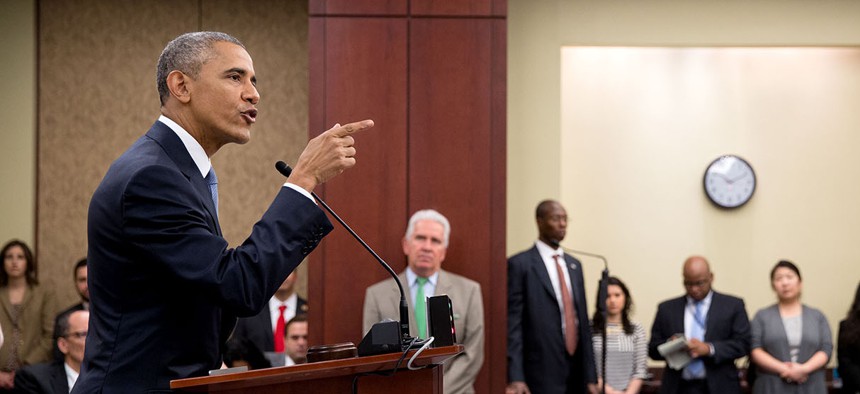
President Barack Obama the House Democratic Caucus at the U.S. Capitol, June 12, 2015. White House photo by Pete Souza
Obama Finally Decides Who’s In Charge When America Comes Under Cyberattack
For years, there’s been confusion in the private sector and among agencies about who does what when hackers hit the homeland. Not anymore.
The White House has placed the Justice Department squarely in charge of responding to cyberthreats against the United States, under a presidential directive issued Tuesday.
At the same time, the Homeland Security Department will immediately help agencies and companies, if requested, stanch the bleeding from a hacker assault on networks, or "assets,” President Barack Obama said.
For years, there has been confusion in the private sector and internally among agencies about who's in charge when hackers hit the homeland.
Justice will take the lead in "threat response" or investigating a system attack on site, identifying the perpetrator and breaking up attack operations because foreign adversaries often are involved.
"In view of the fact that significant cyberincidents will often involve at least the possibility of a nation-state actor or have some other national security nexus, the Department of Justice, acting through the Federal Bureau of Investigation and the National Cyber Investigative Joint Task Force, shall be the federal lead agency for threat response activities," the directive states.
The latest data breach pinned on a foreign country, this time Russia, leaked Democratic National Committee emails in what some foreign policy experts say was a ploy to influence the presidential elections or the next administration's policies.
"This presidential policy directive sets forth principles governing the federal government’s response to any cyber incident, whether involving government or private sector entities," Obama says in the rules signed July 26.
In a Tuesday statement, DHS Secretary Jeh Johnson acknowledged: "I am often asked 'who’s responsible within the federal government for cybersecurity? Who in the government do I contact in the event of a cyberincident?'”
Now, the so-called U.S. Cyber Incident Coordination presidential directive "clarifies the answer to these questions,” Johnson added.
DHS’ role is providing technological help and figuring out what other organizations might be at risk, among other things.
Johnson explained asset response "involves helping the victim find the bad actor on its system, repair its system, patching the vulnerability, reducing the risks of future incidents, and preventing the incident from spreading to others."
In addition, DHS and Justice will produce "a fact sheet" with instructions on how private individuals and organizations can contact relevant agencies about a hack attack.
The director of national intelligence's job will be to assist in aggregating analysis of threat trends, along with helping "to degrade or mitigate adversary threat capabilities."
The military will be responsible for dealing with threats against its own Department of Defense Information Network. Likewise, the DNI will handle incidents that impact the intelligence community IT environment.
First Things First
Whichever federal agency first learns of a cyberincident "will rapidly notify other relevant federal agencies in order to facilitate a unified federal response and ensure that the right combination of agencies responds to a particular incident," the directive says.
Obama expects DHS to write, within the first month of the next administration, what he is calling a "National Cyber Incident Response Plan" that addresses attacks against private-sector networks.
Within 180 days, Homeland Security must submit the critical infrastructure risk plan to the president, which at that point would be either GOP nominee Donald Trump or presumptive Democratic nominee Hillary Clinton.
Tuesday's directive follows Obama's grand Cybersecurity National Action Plan, a strategy released in February along with a congressional request for $19 billion in information security funding.
The new dictate does not override current agency cyber laws, like the Federal Information Security Modernization Act, according to an accompanying annex.
If an incident equates to a "major incident" under FISMA, it counts as a "significant cyberincident" in the language of the new directive and would be managed accordingly. (A significant cyberincident is an episode likely to harm national security, foreign relations or the U.S. economy, or endanger Americans' public confidence, civil liberties or safety.)
In the final months of the administration, federal agencies will have to develop a series of new policies for executing Tuesday’s directive.
Within 180 days, DHS and Justice must finish a concept of operations for a rapid response team, or what the administration terms a "Cyber Unified Coordination Group."
During an incident, the group will act as "the primary method for coordinating between and among federal agencies in response to a significant cyberincident," as well as for looping in the private sector as appropriate, the directive says.
A cyber group will be propped up when hackers hit critical infrastructure operators so hard the effects could be catastrophic, according to the policy.
Earlier today, Lisa Monaco, assistant to the president for homeland security and counterterrorism, explained how the amount of government aid supplied to industry will be based on the risks posed by the hacker threat.
"For instance, what is the impact? How might it affect our national security or economy? Does it threaten the life or liberties of the American people? It also says that the government will appropriately safeguard the privacy, civil liberties, and information of those affected. It commits to unifying the government’s response across agencies. And it emphasizes that our response will be focused on helping victims of cyber incidents recover quickly," she said at the International Conference on Cybersecurity in New York.




